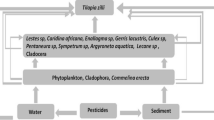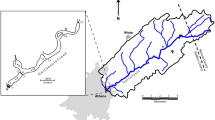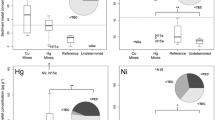Abstract
A fate assessment of the herbicide endothall (AQUATHOL®) was conducted on Pat Mayse Lake, Texas, during the summer of 1983 in conjunction with an aquatic plant management program forMyriophyllum spicatum L. (Eurasian watermilfoil). Aqueous endothall concentrations were below the minimum detectable level of 0.002 mg/L within 72 hr after treatment and below the minimum detectable level in sediments (0.01 mg/kg) within 96 hr. Both dilution and biodegradation probably contributed significantly to rapid transport and degradation. Endothall was not detected in fish tissue on any sampling day. Concentrations considerably less than the label-recommended dose rate for partial surface treatment were measured, indicating that AQUATHOL® may be used in sensitive aquatic environments with minimal nontarget effects.
Similar content being viewed by others

References
Armstrong JG (1974) A review of the literature on the use of endothall in fisheries. U.S. DOC. PB-235 447, National Technical Information Service, Springfield, VA
Cairns, J Jr (1980) Estimating hazard. Bioscience 30:101–107
Carlson R, Whitaker R, Landskov A (1978) Endothall. Zweig G (ed), Analytical Methods for Pesticides and Plant Growth Regulators, Academic Press, New York, pp 327–340
Chiou CT, Freed VH, Schmedding DW, Kohnert RL (1977) Partition coefficients and bioaccumulation of selected organic chemicals. J Agric Food Chem 11:475–478
Holmberg DJ, Lee GF (1976) Effects and persistence of endothall in the aquatic environment. J Water Pollut Contr Fed 48:2738–2746
Klingman GC, Ashton FM, Noordhoff LJ (1975) Weed Science: Principles and Practices. J. Wiley and Sons, New York, 430 PP
Reinert KH, Rodgers JH Jr (1984) Influence of sediment types on the sorption of endothall. Bull Environ Contain Toxicol 32:557–564
Reinert KH, Rodgers, JH Jr, Leslie TJ, Hinman ML (1986) Static shake-flask biotransformation of endothall. Water Res 20:255–258
SAS Institute Inc (1982a) SAS User's Guide: Basics. SAS Institute Inc, Cary, NC, 923 pp
— (1982b) SAS User's Guide: Statistics. SAS Institute Inc, Cary, NC, 584 pp
Serns SL (1977) Effects of dipotassium endothall on rooted aquatics and adult and first generation bluegills. Water Resour Bull 13:71–80
Sikka HC, Rice CP (1973) Persistence of endothall in the aquatic environment as determined by gas-liquid chromatography. J Agric Food Chem 21:842–846
Simsiman GV, Daniels TC, Chesters G (1976) Diquat and endothall: Their fates in the environment. Residue Reviews 62:131–174
Texas Water Development Board (TWDB) (1974) Dams and Reservoirs in Texas Part 1. Report No. 126. Texas Water Development Board, Austin
Yeo RR (1970) Dissipation of endothall and effects on aquatic weeds and fish. Weed Sci 18:282–284
Zar JH (1974) Biostatistical Analysis. Prentice-Hall, Englewood Cliffs, NJ, 620 pp
Author information
Authors and Affiliations
Rights and permissions
About this article
Cite this article
Reinert, K.H., Hinman, M.L. & Rodgers, H. Fate of endothall during the Pat Mayse Lake (Texas) aquatic plant management program. Arch. Environ. Contam. Toxicol. 17, 195–199 (1988). https://doi.org/10.1007/BF01056025
Received:
Revised:
Issue Date:
DOI: https://doi.org/10.1007/BF01056025



